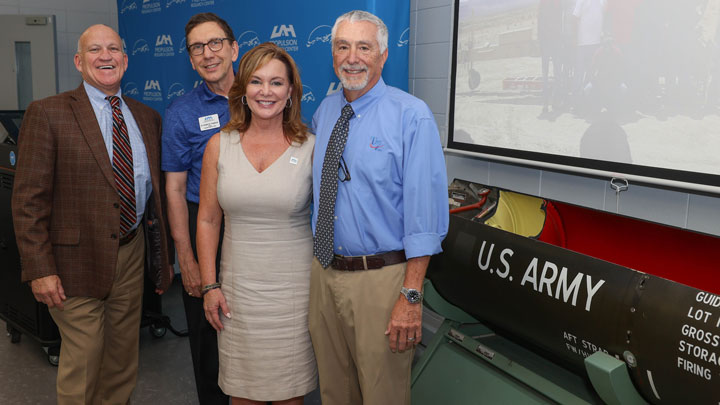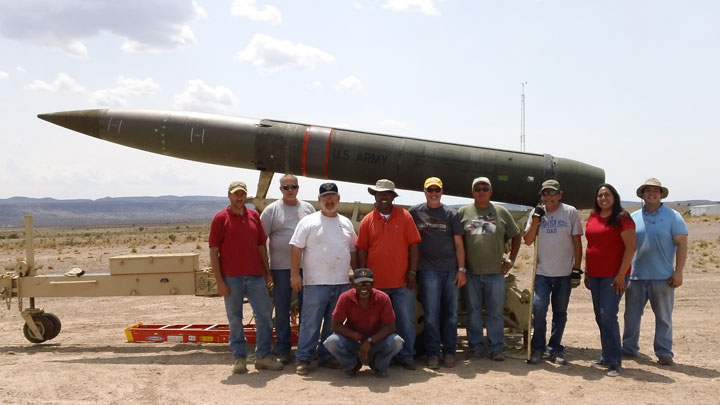The Propulsion Research Center (PRC) at The University of Alabama in Huntsville (UAH) has received a Lance missile display from Troy7, Inc., an aerospace engineering and analytical services company located in Huntsville, Ala., founded by husband and wife team, John and Lynn Troy. John (B.S., Mathematics, and B.S., Computer Science, 1988) and Lynn (B.S., Electrical Engineering, 1992) are both alumni of UAH, a part of the University of Alabama System. The pair share a special connection with the Lance, a mobile field artillery tactical missile system that provided nuclear and non-nuclear general fire support to the Army Corps and played an especially prominent role during the Cold War.
“The Lance was designed to stop the Soviets,” John Troy explained during the presentation ceremony at the UAH PRC. “It really is a fantastic piece of engineering, and it was all done right here in Huntsville. In Wiesbaden, West Germany, we were horribly outmanned for a conventional war. That’s what these were for. Our job was to take out the Russian divisions when they invaded West Germany.”

(L-R) UAH President, Charles L. Karr; Dr. Robert Frederick, director, UAH Propulsion Research Center; UAH alumna Lynn Troy, president, Troy7, Inc.; UAH alumnus John Troy, co-founder of Troy7, Inc.
Michael Mercier / UAH
The contract to develop the Lance was awarded in 1963, and the weapon was first successfully tested at White Sands Missile Range in 1965. The missile system became a target vehicle for the United States Army Space and Missile Defense Command at Redstone Arsenal in 1995 and last flew in 2015 at the Pacific Missile Range Facility in Kauai, Hawaii. Though never flown in warfare, the Lance boasted more than 500 flights over its storied history.
“Students and visitors to our laboratory have been intrigued and interested by the Lance missile display,” says Dr. Robert Frederick, director of the UAH Propulsion Research Center. “We stand around this cut-out rocket, and I can point to and touch all of the inner parts and connect what students will learn about in college, such as fluid mechanics, structures, dynamics and chemistry, to how the system operates. I am also planning to have one of my rocket propulsion classes do a reverse engineering of the system to engage students in applying the propulsion skills they learn in the classroom to a historic propulsion system.”
John Troy is now retired from his position as Owner/Chief Scientist at Troy7, a career that spanned from 2007 – 2020, after a stint at Teledyne Brown Engineering that saw him rise through the ranks in that organization from 1988 – 2007. Lynn Troy stayed on as President of Troy7, now a subsidiary of Yulista Holding, LLC, after beginning her career at Teledyne Brown as well.
“I never thought I would leave Teledyne Brown,” Lynn remarked at the ceremony, recalling the founding of Troy7. “It was a very big crossroads in our careers. After John and I retired on the same day, we said let’s just quit our jobs. We called it our Titanic moment. Just jump in and see where it leads us. A year later we were heavily involved in the flight history program out at White Sands.”
A powerful deterrent to aggression

John Troy, co-founder of Troy7, Inc., shows off Lance missile cutaway displayed in its new home at the UAH Propulsion Research Center.
Michael Mercier / UAH
“I started here in 1987,” Lynn Troy went on, reminiscing about her days at UAH. “I was blessed to get a co-op job with Teledyne Brown. I landed in the optics department and loved it. I learned how to work with infrared and radar target systems. My job was to take what we had and make it look like something the Russians or Chinese might be shooting. I did a lot of materials characterization as well and a lot of flight testing. All the flight testing had to be in person. That job led me to meeting John. The Lance became John’s favorite missile.”
John’s first encounter with the Lance system was at White Sands Missile Range in New Mexico as part of an Army unit deployed to investigate why one of the missiles had accidentally veered off course on a test flight.
“It was a great missile to work on,” John noted, indicating the Lance display in its new home at the PRC, an exhibit that reveals the inner workings of the missile’s mechanism. “We figured out what the problem was. We took six of these to Redstone Arsenal and tested two of them. We figured one would fail and one would be successful, and that’s what happened. We reconfigured them.

John Troy, co-founder of Troy7, Inc., with White Sands missile flight test crew.
Courtesy John Troy
“The Lance was designed to be storable,” the Troy co-founder continued. “They would put them in bunkers and could roll them right out on a moment’s notice. A lot of the NATO countries had Lance. The engine is two engines in one, the outer booster engine and the sustainer engine. There really is nothing like it. It was super easy for a combat mission. All you needed was an azimuth and an elevation. You roll in the numbers on the monitor control board, and it’s set to fly.”
The system was also known for its speed, reliability and durability. “The thing gets up and gets out in a hurry. You hit Mach 3.0 in about six seconds,” John remarked at the ceremony. “It had a 99% success rate. It was literally bullet proof. You could fire a .50 caliber round into it, and it would still function.”
Finding a new home at UAH at the end of the Lance’s long and vital deployment parallels the journey of the Troys themselves, bringing everything full-circle back to where it all began. “I feel like I’m living the dream,” Lynn Troy said. “It thrills me and John to see the Lance here, that it landed in our alma mater.”